

Chassis: McLaren Racing Class: F1 2014 Engine: Mercedes Benz PU106A Fuel: Petrol Transmission:8 speed sequential Brakes: Carbon/Carbon 0 Weight: – Fuel Tank: ATL Year introduced: 2014
McLaren revealed images of its 2014 car just before the start of the Jerez Pre-season test. In a statement the team said: “We have responded to the disappointment of our 2013 season by pragmatically framing our approach to the technical challenge. The new MP4-29, is a sensible and calculated response to the new regulations. But it is very much a frozen snapshot of the design team’s steep development curve, and, as such, a machine that will potentially undergo more technical change throughout a single season than any other car in McLaren’s long and illustrious history.
The challenge for 2014 is to build-in both performance and reliability – something that can no longer be taken for granted given the steep technical challenge ahead.
And that is entirely as it should be: for this season will be Formula 1’s steepest-ever learning curve.
It is also a time of transition. Our final season with our engine partner, Mercedes-Benz, will be our 20th together, before we begin an exciting new journey with Honda from 2015.”
The MP4-29 is fitted with the Mercedes Benz PU106A power unit, which common to all 2014 power units has a 1.6 litre direct injection turbocharged engine as well as a twin hybrid system.
““We’ve never had such significant new regulations before; reacting to them, and managing those changes, while still pushing the performance limits, has been an extremely tough job” admits Jonathan Neale. “We’ve been relatively pragmatic about it. We know that the need for consistency initially outweighs the need for performance – the winter tests won’t be about chasing set-up or refining the car; the envelope of performance is likely to be so wide, and so relatively unknown, that the winter – and to some extent the opening races – will be about understanding the operational boundaries of the car as best we can. To achieve this, we need a consistent platform – one that responds positively to changes. Moreover, the work of the engineers and designers to understand and interpret trackside data will be more important than before. That’s because this year, more than ever, will come down to a development race: I don’t necessarily think you can expect the car that wins the opening race to be the car that leads the championship charge, something we’ve often seen in the past. No, it will be all about a team’s ability to react and respond. We already have an update package that we’re readying for race one, and we’re discovering new things in the ’tunnel, or in CFD, all the time. Once we start track testing, I think you’ll see an intense throughput of ideas and concepts – that’s the nitty-gritty that will win or lose the world championship.”
LAUNCH – TECHNICAL ANALYSIS
As McLaren did not stage a proper car launch as usual there were only a few images to work with ahead of the Jerez test. But they were still revealing none the less. Instantly noticeable on the car is the nose.
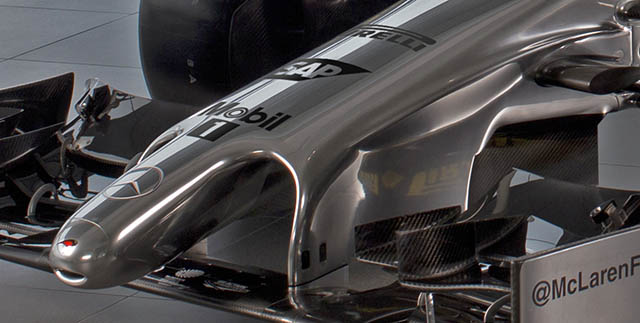
It is the strange shape that it is due to a new for 2014 regulation governing nose height.
The chassis around the driver’s legs and feet is also now significantly lower – due to a regulated drop in maximum height at the front bulkhead. Chassis nose-height is lowered even further, resulting in some novel structures at the front of the car in order to meet compliance. The area under the chassis is crucial from an aerodynamic perspective so it will be interesting to find out what lies beyond the nose structure. A small chin style feature can just be seen in the image above.

At the rear the suspension layout seems conventional, with a pullrod layout. The impact of the higher gearbox is also evident (a symptom of the engines having a higher crankshaft height). Note though that the driveshaft is not shrouded. This is clearly an area for more development.
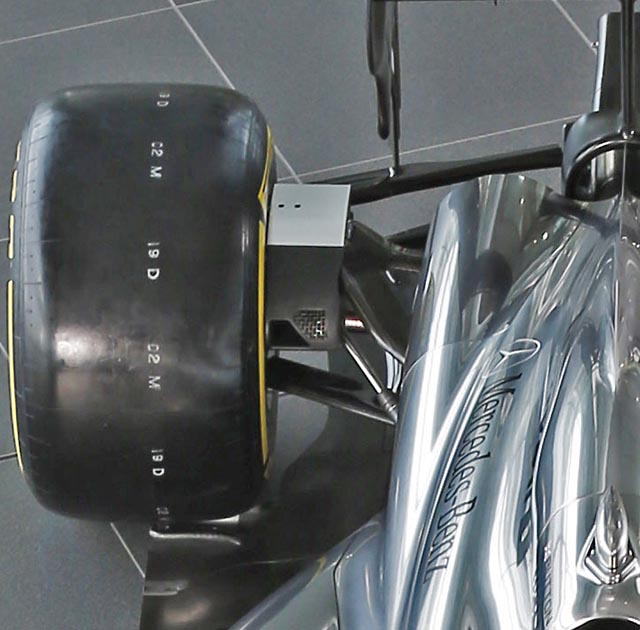
A look at the rear suspension from above shows the length of the rear wishbone arms. Whilst it looks the rear wing is mounted to the wishbone directly that is an optical illusion, the wins is supported by a central pillar mounted onto an interesting semi circular feature above the transmission.
Not the design of the bake duct, very neat indeed, though unlikely to be used in competition we suspect. Also note the cut out in the floor in front of the rear wheel.
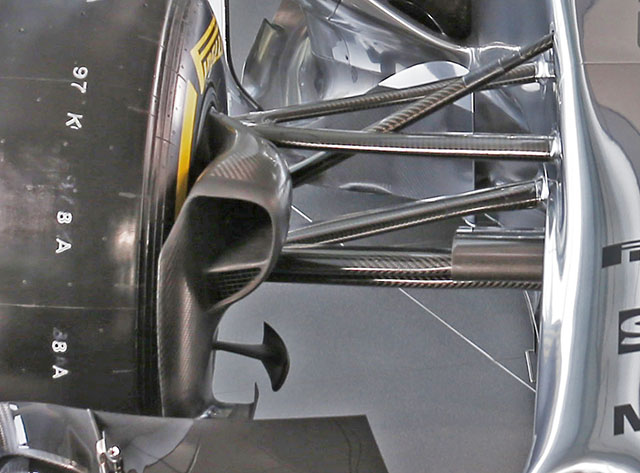
McLaren has dropped its pull-rod front suspension, used on the MP4-28 and has reverted to a conventional pushrod layout. The brake duct design is very interesting, note the ‘hammer’ turning vane.

As expected the sidepods on the car are much larger than in previous years due to the increased cooling demands of the new power units. The side pod turning vane seems a simplified version of what will be seen on the car when it reaches Melbourne for the first race of the year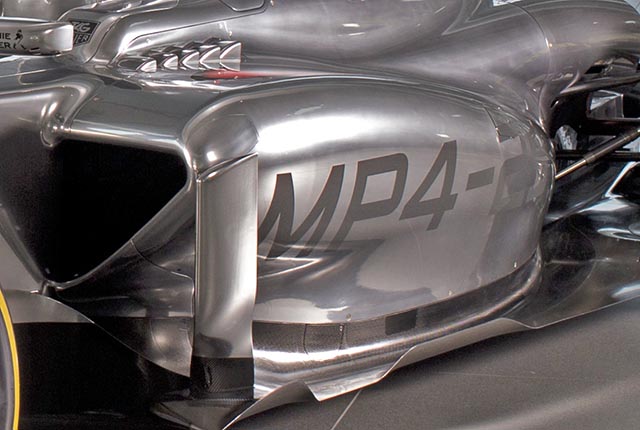
The larger size of the sidepods is clear here, note the sculpting on the outer edge of the floor as well as the centreline cooling gills. More cooling is expected to appear on the MP4-29.
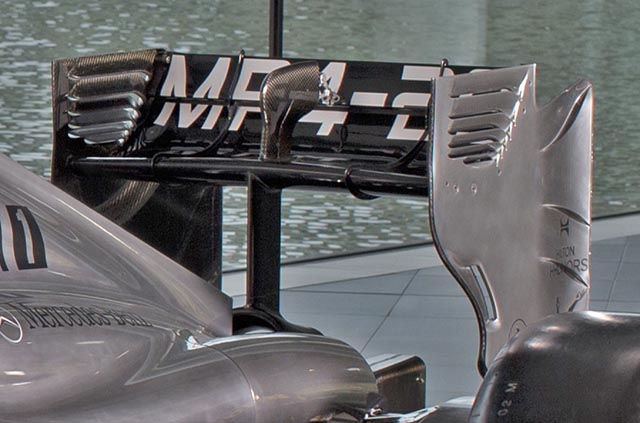
The rear wing of the MP4-29 features a number of carry over elements, such as the Ferrari style endplate strakes and the two ribs on the main plane.

The 2014 roll hoop (above) is very different in shape to the 2013 version (below) it is also possibly larger.
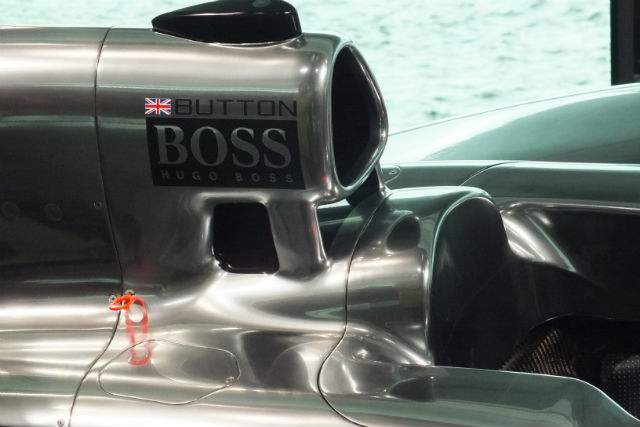
The MP4-29 has four exposed supporting legs, something seen on cars from Sauber (below) and Force India in the past. The 2013 McLaren only had two supports. It is a crucial area for teams to work on, the metal structures are mounted at the highest point on the car so weight reduction is very important.
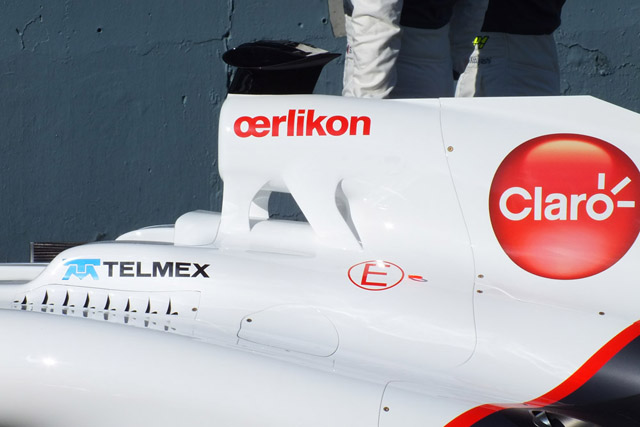
TEST 01: JEREZ, SPAIN
McLaren did not get much (any?) running on the opening day of the test, but the dismantled state of the MP4-29 gave a very good look at the design of the rear brakes and upright.

At the rear of the car a new monkey seat winglet has appeared above the exhaust exit. It is mounted via a swan neck support from the semi circular part of the rear wing mounting. Note the slot in the leading edge of the rear wing endplate.
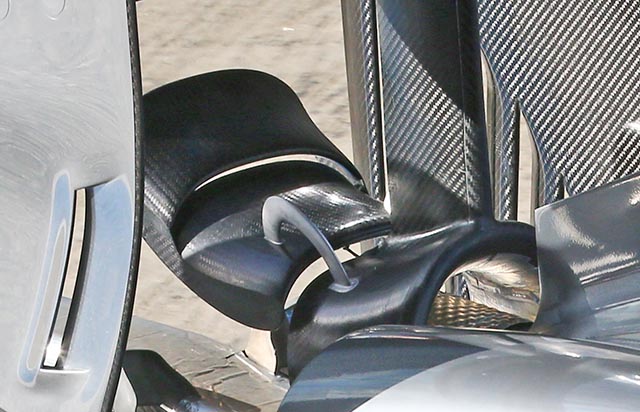
At the launch the rear suspension drew some some interest with length or the suspension arms. Overall the rear suspension design is a relatively conventional pull rod layout. Note the un-shrouded driveshaft.
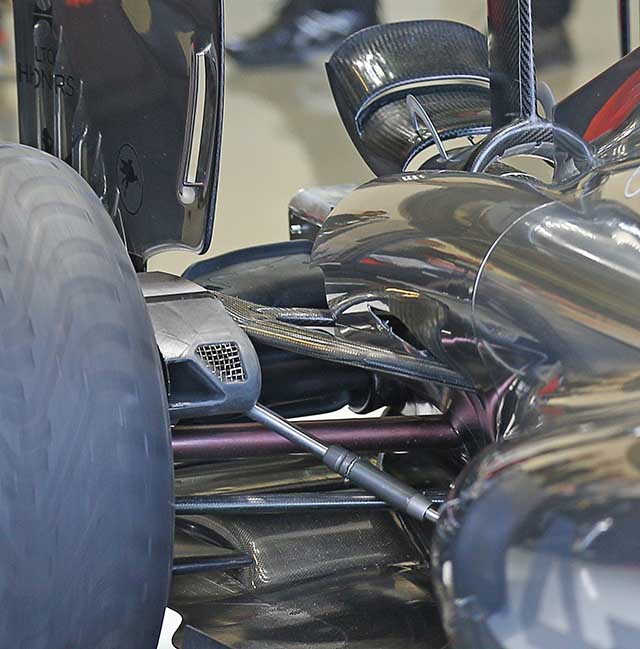
It is not the overall rear suspension concept which has drawn so many comments at in the paddock at Jerez. Instead it is the butterfly like components which have already been nicknamed ‘Mushrooms’.
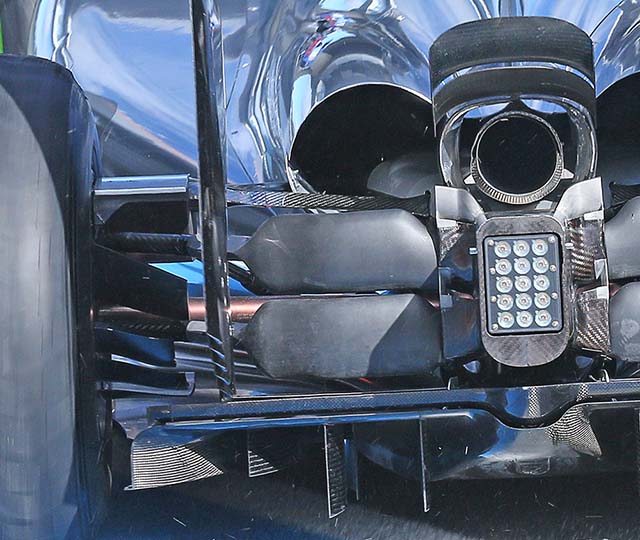
The exact purpose of the Mushrooms is not clear, at first glance it appears that they would merely induce drag, the exact opposite to what you want with 2014’s efficiency based formula. One theory is that they create a change in pressure that draws air either through the cooling system reducing drag, but that does not seem to fully stack up. The shape of the mushrooms seems to have very subtle curvature along the base and the rear face. The above image also show off the cluster of tiny winglets around the rear impact structure and rain lights.
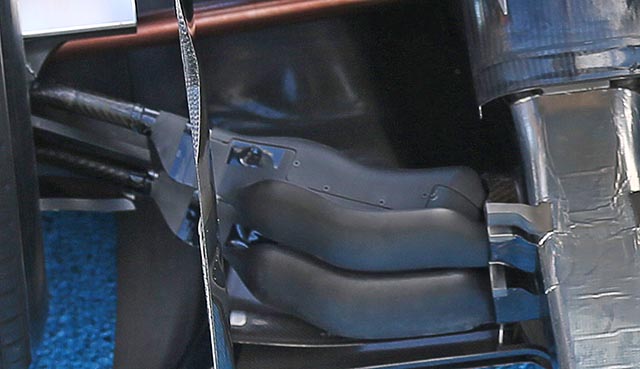
The purpose of the mushrooms is clearly aerodynamic and related to the flow structures below the rear wing and above the diffuser. Both mushrooms appear to affixed to the upper part of the wishbone, but there is also a separate shroud over the wishbone with a curved leading edge.
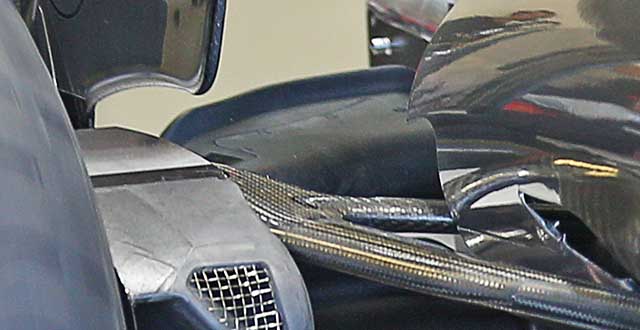
The upper portion of the mushroom has a lip on the trailing edge and is clearly a more complex shape than is apparent from the rear. Perhaps in such a way that it does not reduce drag. The upper edge of the lip has a very subtle curve in it. Its colour and texture looks rather like it has been made on a rapid prototyping machine (3D printing to trendy people). The material used is very similar looking to the Windform materials produced by CRP Technology.
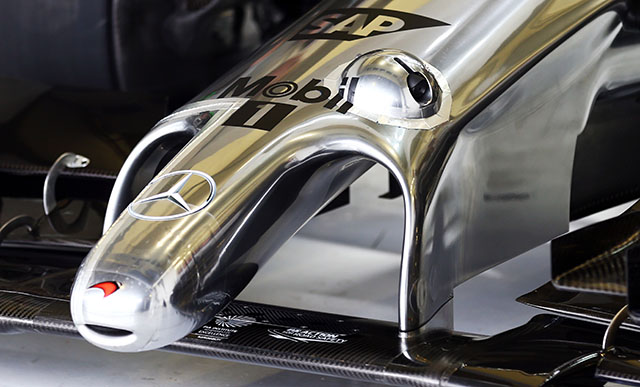
The McLaren was fitted with a neat sensor blister on its nose at Jerez for some runs, but on others carried substantial instrumentation.

Here you can see the car running with its adjustable height pitot tube array. Which can be adjusted whilst the car is in motion from various positions behind the front wheel allowing the team to correlate real air flows with both PIV in the wind tunnel and CFD results. Also present are twin pitot tubes rising from thew rear wing endplates.
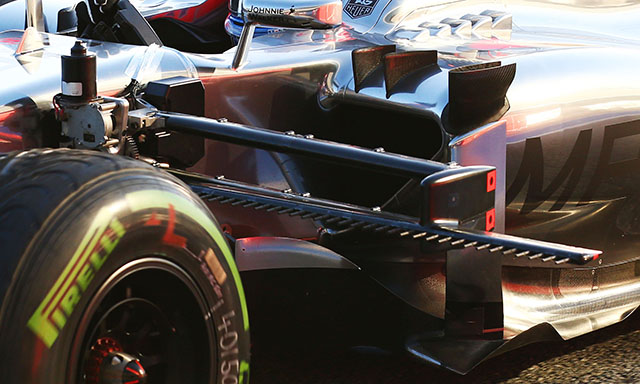
A hot air extractor is fitted to the outer edge of the side pod inside a turning vane. Also note the turning vanes on top of the cars side pod.

Here we get a good look at the airflow of the underside of the McLaren rear wing as the flow vis dye has left its stream lines.
TEST 02: SAKHIR, BAHRAIN
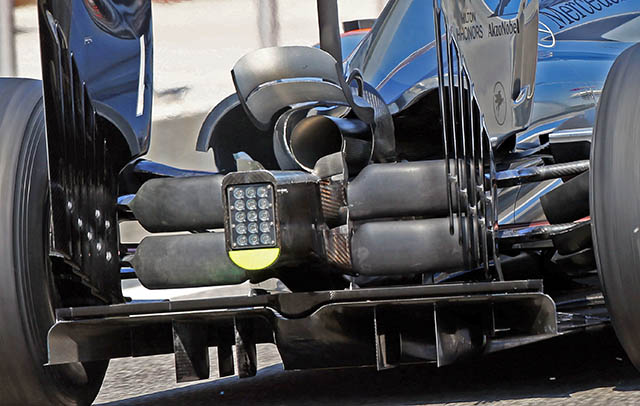
McLaren made some changes to the rear of the car at the second test, including the addition of a gurney around the trailing edge of the engine cover (above and below). The underside of the ‘money seat’ winglet was additionally coated with a ceramic thermal barrier (hence the white colour) due to the effect of the hot exhaust gasses. This is probably the work of English company Zircotec which supplies most of the teams.
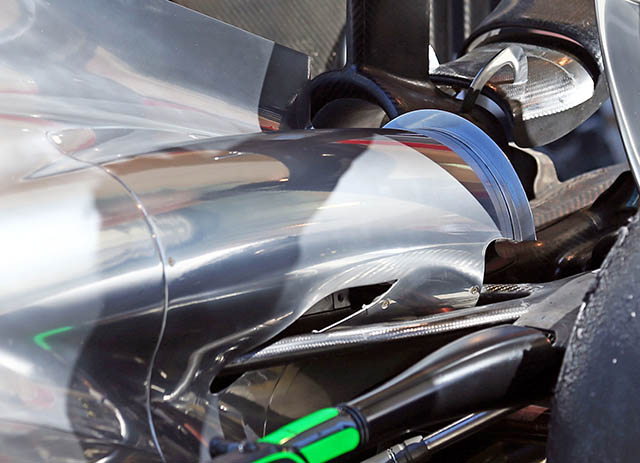 Just how hot the gasses out of the tailpipe are is clear from the shot below. The upper surface of the rear impact structure is clearly badly burnt. Most teams have the exhaust exit blowing onto the upper surface of the rear impact structure, the impact of this on its effectiveness is unknown. Note the shape of the ‘mushroom’ diffuser stalling devices.
Just how hot the gasses out of the tailpipe are is clear from the shot below. The upper surface of the rear impact structure is clearly badly burnt. Most teams have the exhaust exit blowing onto the upper surface of the rear impact structure, the impact of this on its effectiveness is unknown. Note the shape of the ‘mushroom’ diffuser stalling devices.
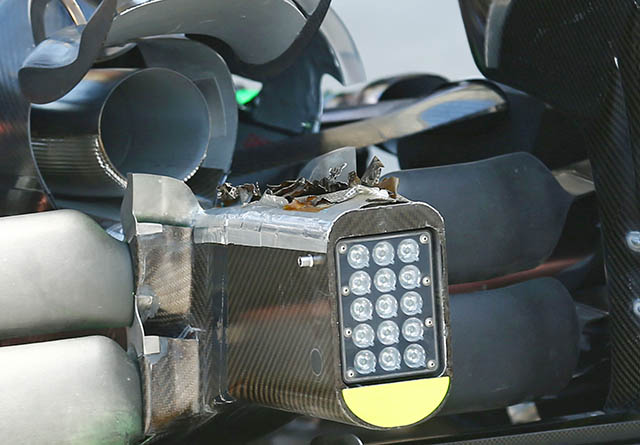
The MP4-29 has three ducts in the roll hoop. The division in the main air box duct is clear to see (below) the upper portion is likely for cooling components at the rear of the car (like the transmission) whilst the lower portion is likely to feed the plenum with combustion air. A third duct, used for cooling, is situated behind the drivers helmet and under the main roll structure.
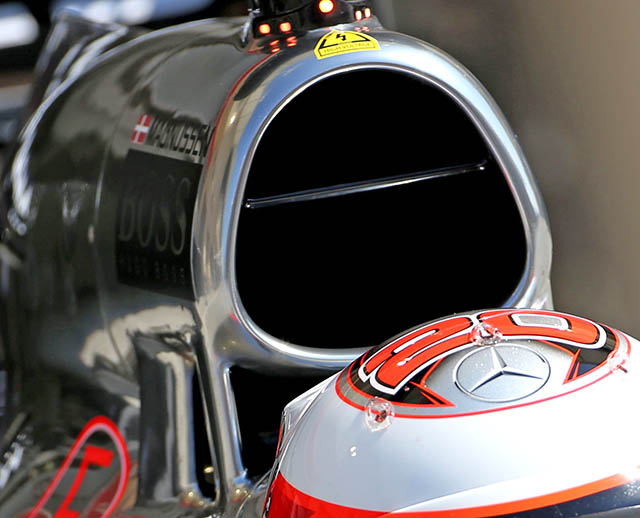
The controversial mushrooms had a new look at Bahrain (below), being made of carbon fibre. At Jerez with four elements attached to the rear suspension appeared to be made from rapid prototype material such as CRP’s Windform family. This suggests that the parts were a fairly late addition.

A fairly minor detail is also just visible in the picture above – enhanced below. Well thats not quite accurate the lack of the detail is what is evident.
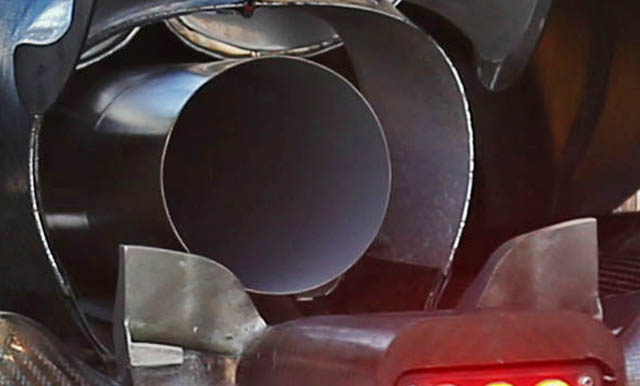
What is missing is part of a heat shield on the tailpipe, in the image below, taken at Jerez the lower half of the pipe is clad in a heat shield material similar to that offered by SS Tube Technology, this is in common use in Formula 1 this year. The loss of this cladding is interesting, as McLaren clearly no longer feel the need to shield whatever lies beneath the tailpipe (the transmission?) from its radiant heat, or it has found another, unseen, solution.
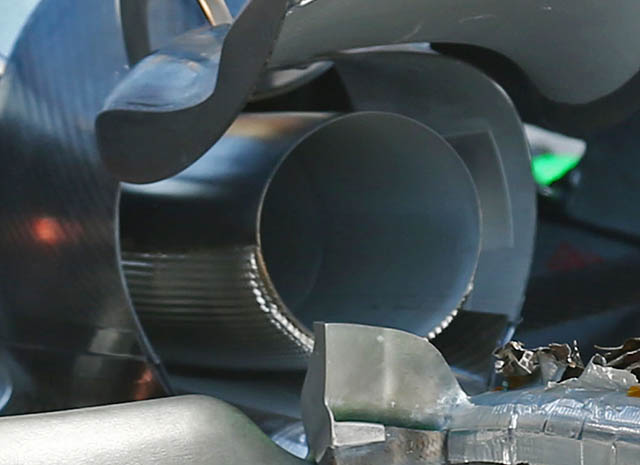
Part of that solution could be below. The McLaren was fitted with new cooling gills on the final day of the test. These holes are curiously not considered holes in the eyes of the FIA. To meet the rules on openings each of the ‘holes’ is linked together by a hairline crack, too narrow to have an aerodynamic impact but wide enough for all seven openings (including the one for the wishbone movement) to be defined as a single hole.
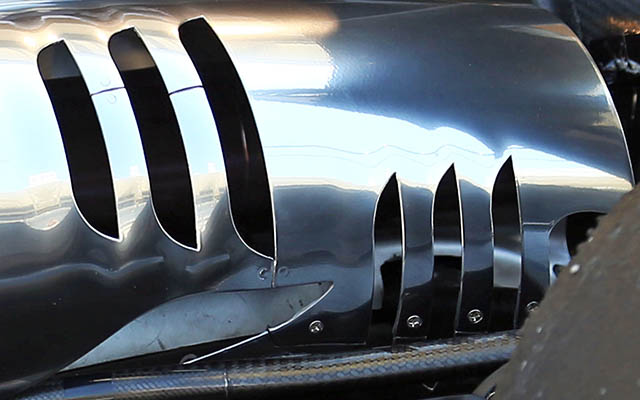
TEST 03: SAKHIR, BAHRAIN
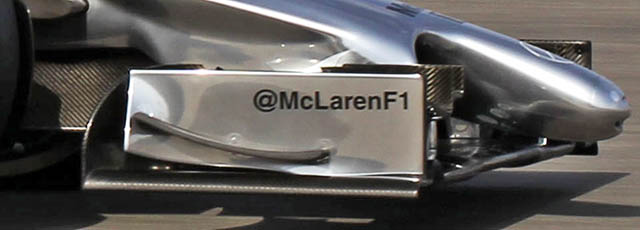
At the final test a new element was added to the front wing endplate (above), in both previous tests the end plate had been deceptively simple (below)
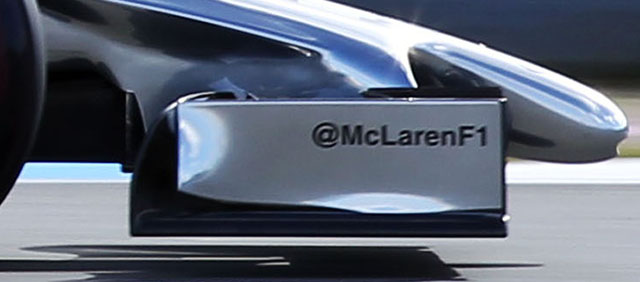
With the revisions to the front aero a number of flow visualisation runs were conducted with the area of focus obvious to see.
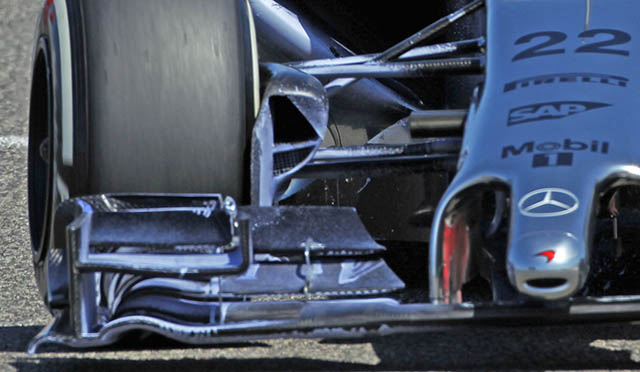
RACE 01: ALBERT PARK, MELBOURNE, AUSTRALIA
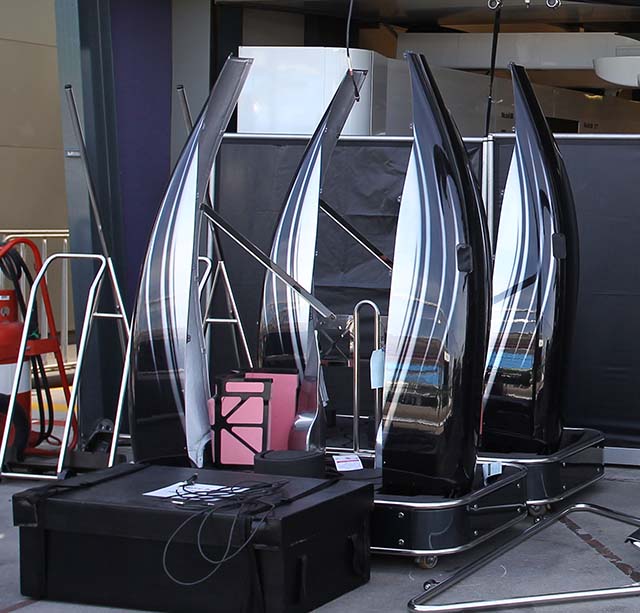
McLaren appear to be running a new paint job at the Australian Grand Prix








